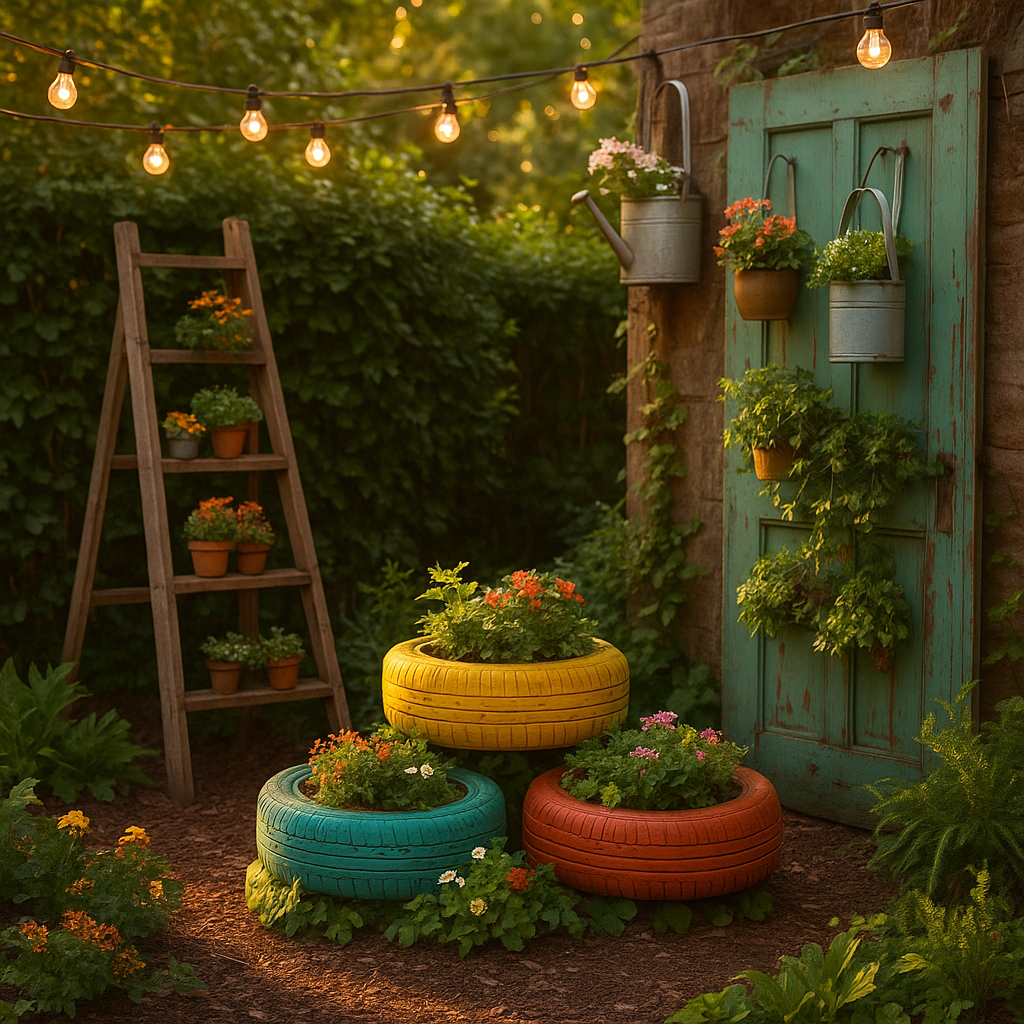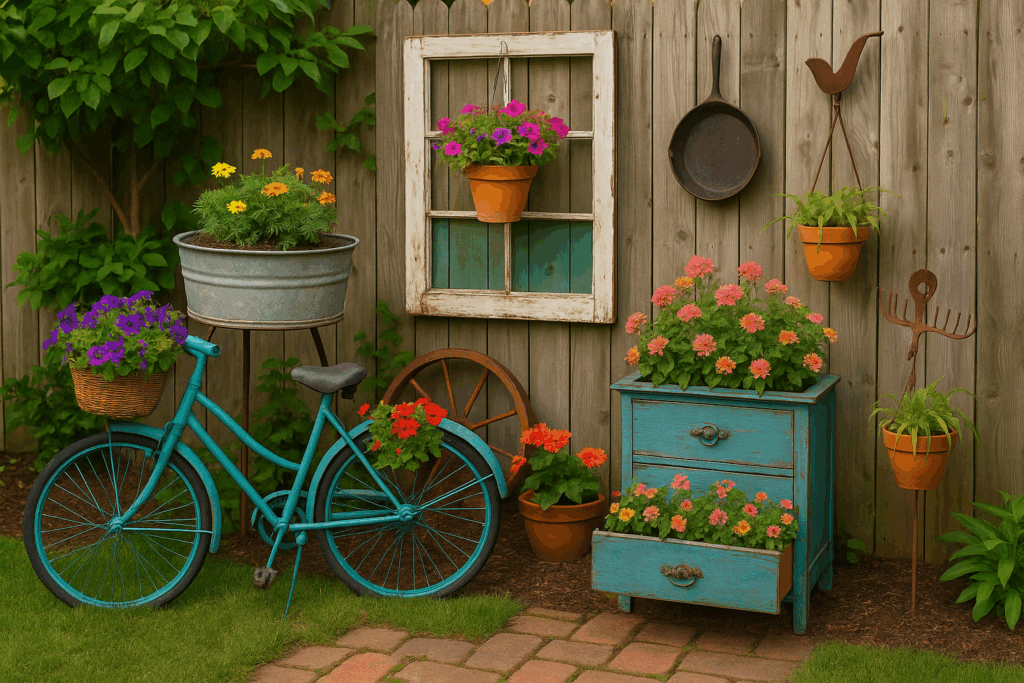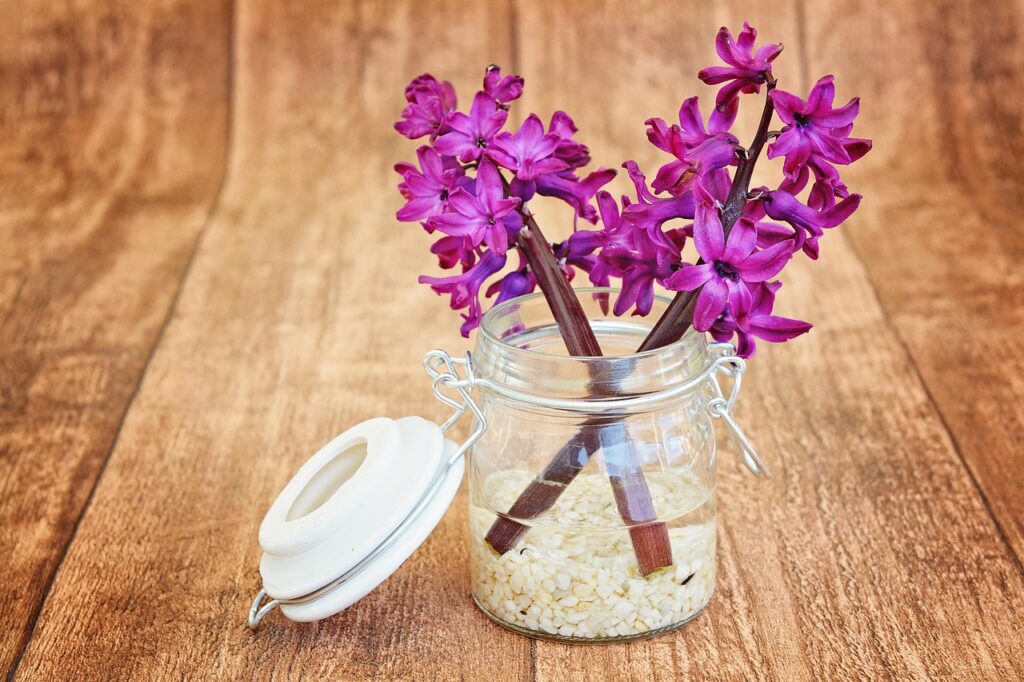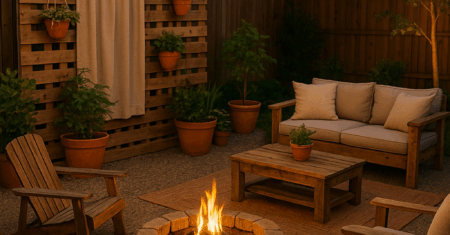♻️ Repurposing Old Items for Unique Backyard Decor: Sustainable Transformation

Introduction
Transforming your backyard into a personal oasis doesn’t have to empty your bank account. Within the universe of DIY garden projects, repurposing old items for unique backyard decor stands out as one of the most creative and economical strategies. This approach not only significantly reduces costs but also adds personality and history to your outdoor space. By giving new life to forgotten objects, you create exclusive decorative elements that tell stories and express your individuality, transforming your backyard into a true reflection of your personal style.
What You’ll Find in This Guide
To understand how to completely transform your outdoor space, check out our 10 Budget-Friendly DIY Projects to Transform Your Backyard into an Oasis.
In this specific article about repurposing, you’ll discover:
🔄 How to identify items with transformation potential
🛠️ Simple techniques to convert old objects into backyard decor
🌱 Creative ideas for planters, furniture, and decorative elements
💰 Tips to save money while creating a unique and personalized space
🔍 Step-by-step projects with surprising results
Why Repurposing Makes Sense for Backyard Decor
According to a recent sustainability survey, 78% of homeowners are looking for ways to reduce waste while decorating their outdoor spaces. Repurposing old items isn’t just environmentally friendly—it’s also incredibly budget-conscious. When you transform existing objects into backyard decor, you’re not just saving money that would otherwise go toward expensive store-bought items. You’re creating something uniquely yours that carries history and character that mass-produced decorations simply can’t match.
Whether you’re working with a tiny urban patio or a sprawling rural backyard, repurposed decor adds visual interest and conversation starters to your outdoor sanctuary.
Finding Hidden Gems: Where to Look for Repurposing Treasures
Scouring Your Own Home
The first place to start your treasure hunt is right in your own home. Look for:
- Old wooden furniture that’s seen better days
- Kitchen items like colanders, teapots, or unused cookware
- Broken or incomplete items that could find new purpose
- Vintage suitcases, trunks, or containers
- Children’s toys they’ve outgrown
Pro Tip: Before discarding any household item, ask yourself: “Could this have a second life in my backyard?” Often, items you consider useless have the greatest potential for creative transformation.
Thrift Store Finds and Roadside Treasures
Beyond your own home, consider hunting for potential decor items at:
- Thrift stores and secondhand shops
- Yard sales and estate sales
- Flea markets
- Curbside pickup on neighborhood trash days
- Online marketplaces like Facebook Marketplace or Craigslist
When shopping these sources, look beyond what an item is currently and envision what it could become. That rusty bicycle might make a perfect garden trellis, while old wooden shutters could transform into a charming outdoor privacy screen.
Remember that items with interesting shapes, textures, or finishes are often the best candidates, even if they’re damaged in ways that would make them unusable for their original purpose.

Easy Transformation Projects for Beginners
Unique Container Gardens from Everyday Items
One of the simplest ways to start repurposing is by creating container gardens. Almost anything that can hold soil can become a planter:
- Old boots and shoes – perfect for small succulents or herbs
- Vintage toolboxes – great for trailing flowers
- Chipped teacups and teapots – ideal for small indoor-outdoor plants
- Wooden crates and drawers – excellent for herb gardens
- Metal washtubs and buckets – perfect for larger plants or small trees
Steps for Creating Container Gardens:
- Clean your container thoroughly
- Drill drainage holes if needed
- Add a layer of gravel for drainage
- Fill with appropriate potting soil
- Plant your chosen flowers, herbs, or vegetables
- Place strategically throughout your yard for visual interest
These container gardens can be arranged at different heights using old step ladders, tree stumps, or repurposed shelving to create dimension in your backyard design.

Tackling Larger Projects: Furniture and Focal Points
Creating Statement Pieces from Unexpected Materials
For those ready to take on bigger projects, consider these transformation ideas:
- Old Door Coffee Table: Remove an old wooden door from its hinges, clean it thoroughly, add suitable legs (repurposed from another piece or purchased), and finish with weather-resistant sealant.
- Window Frame Trellis: Attach old window frames to a garden wall to create an architectural trellis for climbing plants.
- Ladder Plant Display: Sand and paint an old wooden ladder, then position it against a wall or fence to create tiered plant display.
- Tire Ottomans: Clean old tires, wrap them with rope or fabric, add a cushioned top, and you have weather-resistant outdoor seating.
Attention! When working with painted items, especially those made before 1978, test for lead paint before sanding or modifying. Lead test kits are available at most hardware stores.
For more detailed transformation projects, check out our related article on ((Transform Your Patio with These 5 Low-Cost Ideas
Weatherproofing and Maintaining Your Repurposed Decor
To ensure your creative projects withstand the elements:
- For Wood Items:
- Sand thoroughly
- Apply exterior-grade primer
- Finish with 2-3 coats of outdoor paint or marine-grade varnish
- Reapply protective finishes annually
- For Metal Objects:
- Remove rust with wire brush or sandpaper
- Apply rust converter product
- Prime with metal primer
- Finish with exterior metal paint
- Consider clear protective spray for added protection
- For Fabric Elements:
- Choose outdoor-rated fabrics when possible
- Apply fabric waterproofing spray
- Store removable fabric elements during extreme weather
- Replace seasonal decorative elements as needed
Regional Consideration: In coastal areas, metal items will require more frequent maintenance due to salt air. In very sunny regions, choose UV-resistant paints and finishes to prevent fading.
Bringing It All Together: Creating a Cohesive Look
While the charm of repurposed decor lies in its eclectic nature, creating some visual cohesion will enhance your backyard’s appeal. Consider these strategies:
- Use a consistent color palette across different repurposed items
- Group similar items together for greater visual impact
- Balance “busy” repurposed pieces with simpler elements
- Create focal points rather than spreading items evenly throughout the space
- Incorporate lighting to highlight your favorite repurposed creations
Your repurposed backyard decor doesn’t just beautify your outdoor space—it creates a sustainable, budget-friendly oasis that reflects your creativity and personal style. By giving new purpose to old items, you’re creating a backyard that’s not only environmentally responsible but also uniquely yours.
For more comprehensive backyard transformation ideas, don’t forget to check out our main guide on 10 Budget-Friendly DIY Projects to Transform Your Backyard into an Oasis.
Frequently Asked Questions About Repurposing for Backyard Decor
🪴 What household items make the best planters?
Items with good drainage potential work best. Old colanders, boots, toolboxes, and even broken appliances like washing machines can make excellent planters. Just ensure proper drainage and soil depth for your chosen plants.
🔨 Do I need special tools to repurpose items for my backyard?
Basic tools are usually sufficient: a drill with various bits, sandpaper, screwdrivers, pliers, and a hammer. More specialized projects might require a saw or other tools, but you can start with simple projects that match your existing tool collection.
🌧️ How do I make sure my repurposed decor survives winter weather?
For seasonal protection, either move smaller items to a covered area or use weather-resistant covers. Apply appropriate sealants and weather-resistant finishes, and perform annual maintenance before harsh weather seasons begin.
🎨 Can I create a cohesive look when using different repurposed items?
Absolutely! Unify disparate items by using a consistent color palette, similar finishes, or complementary themes. You can also create cohesion by grouping similar items together or using them for similar functions throughout your space.
Additional Resources
Ready to start your repurposing journey? Check out these helpful resources:
- 10 Budget-Friendly DIY Projects to Transform Your Backyard into an Oasis
- Transform Your Patio with These 5 Low-Cost Ideas
- DIY Vertical Garden Systems for Small Patios: Space-Saving Solutions
- The Importance of Ergonomic Design at Home for Physical Health
- Native Plant Gardening by US Region: Best Native Plants for Midwest Gardens
Have you repurposed items for your backyard before? What creative transformations have you made? Share your experiences in the comments below.

0 Comments